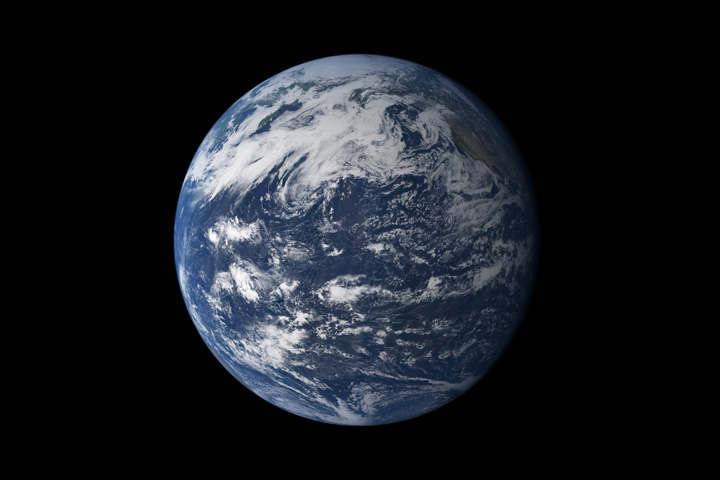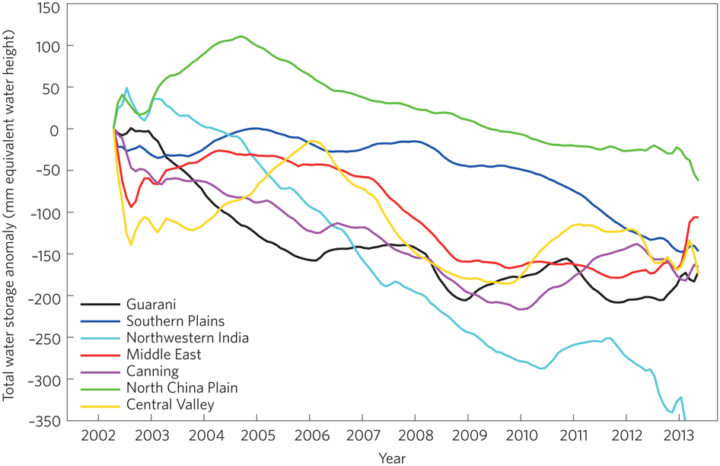Maybe you have heard people call Earth “the water planet.” The nickname is well-deserved. As this mosaic of images from the Moderate Resolution Imaging Spectroradiometer (MODIS) on the Terra satellite conveys so well, the majority of Earth’s surface is covered by either liquid or frozen water. The atmosphere is awash with water as well. One satellite-based data set estimates that about 60 percent of Earth’s surface is covered by clouds (composed of water and ice droplets) at any given time.
Earth is home to yet another type of water—groundwater—which includes all the fresh water stored underground in soil and porous rock aquifers. Though groundwater is often forgotten because it’s not visible, more than two billion people rely on it as their primary water source.
With drought afflicting several parts of the world, and with aggressive use of groundwater in many agricultural regions, this precious water resource is under serious strain, warns NASA Jet Propulsion Laboratory hydrologist James Famiglietti. In a commentary published by Nature Climate Change in October 2014, Famiglietti wrote:
In many parts of the world, in particular in the dry, mid-latitudes, far more water is used than is available on an annual, renewable basis. Precipitation, snowmelt, and streamflow are no longer enough to supply the multiple, competing demands for society’s water needs. Because the gap between supply and demand is routinely bridged with non-renewable groundwater, even more so during drought, groundwater supplies in some major aquifers will be depleted in a matter of decades. The myth of limitless water and the free-for-all mentality that has pervaded groundwater use must now come to an end.
Most of the major aquifers in the world’s arid and semi-arid zones—the parts of the world that rely most heavily on groundwater—are experiencing rapid rates of depletion because of water use by farms. As shown in the chart above—based on data collected by the Gravity Recovery and Climate Experiment (GRACE)—this includes include the North China Plain, Australia’s Canning Basin, the Northwest Sahara Aquifer System, the Guarani Aquifer in South America, the High Plains and Central Valley aquifers of the United States, and the aquifers beneath northwestern India and the Middle East.
The situation is looking particularly grim in California, a state currently suffering from extreme drought. The extent of the drought is visible in the series of GRACE maps of dry season (September-November) water storage anomalies shown below. Red areas show the height of the water in comparison to a 2005-2010 average. California’s Sacramento and San Joaquin river basins have lost roughly 15 cubic kilometers (4 cubic miles) of total water per year since 2011 — more water than all 38 million Californians use for domestic and municipal supplies annually. Over half of the water losses are due to groundwater pumping in the Central Valley, according to Famiglietti.
The first step to managing the globe’s groundwater problem is to accept that we have one, Famiglietti recommends. And when societies are ready to look for solutions, the first place they’ll have to turn is the agricultural sector. “Agriculture accounts for nearly 80 percent of water use globally, and at least half of the irrigation water used is groundwater,” he wrote. “Even modest gains in agricultural efficiency will result in tremendous volumes of groundwater saved, or of water available for the environment or other human uses such as municipalities, energy production, industry and economic growth.”
Read the full commentary here. You can read news reports about Famiglietti’s article from Mashable, the Financial Times, and Discovery News. Read more about observing groundwater from space in “The Gravity of Groundwater.” Watch Famiglietti give a TEDx talk about groundwater losses below.







Houston – “We have a problem”……..
Please send me ppt
I believe there is another source of depletion impacting our ground water. While I have no scientific data to support this, logically over time this will have an impact. I am referring to the thousands or more, of partially empty plastic bottles of water that are thrown away daily. People give no thought to tossing these bottles in the thrash without first emptying the contents, trapping the contents for years in the plastic bottles. Without data to support this, it may seem insignificant. I would argue that when you multiply the thousands of times a day this occurs, it will eventually have a negative impact. My suggestion is to invest in an awareness campaign similar to recycling. If people are aware they will change their habits, take the two seconds it takes to empty the bottle before they throw it in the trash, trapping that water for however many years takes that plastic bottle to deteriorate.
You don’t land $1.3 billion on a comet unless it’s for the purpose of mining comets in the future for water. SpaceX, and Ad Astra are the next big IPOs. ORB will be acquired by SpaceX.
Believe it or Not – the Solar Flares from the Sun cause vaporization of the entire Earth’s water particularly with larger and more ozone holes around us. Just as happened on MARS it is happening on our planet. Cloud seeding and tampering with the weather has caused an imbalance and we are all at risk now as a result of it. The first indication is extinction of many insect and animal species then we will be next. Just look at the satellite photos of the changes happening both above us, the surface and within our planet. Also you cannot get away with continual extraction of oil which eventually will result in shrivelling and cracking even splitting the planet apart. All the money in the world will not help any of us then and all the wars going on. We are in serious trouble and most of the people do not even realize it yet.
We’re starting to bump up against the limits imposed by the laws of thermodynamics. Here, the law of conservation of mass/energy: matter/energy cannot be created or destroyed – only its form can be changed. For most of recent history, there’s always been another energy source to exploit, or more untapped resources. Our societies are like trust fund kids, who keep spending capital because there’s so much, it cannot be exhausted… until, one day, the money’s gone.
There’s only so much water on the planet – no matter what technical wizardry is invented for making it drinkable, sooner or later, all the water will be in use. What then?
Mucho he pensado en esto, y he escrito las posibles causas, y leyendo el comunicado 14-280 del 9 de octubre sobre “punto caliente de metano en eeuu”, creo que una de las causas de la desaparicion de las aguas en el Oeste es debido al fracking, un proceso que consume mucha agua.
wut about the government …we as people kno we cannot survive without water..we also kno the end is near..there is the space station..which is our species next…( world )..so i wonder how much of our water is being sent there?